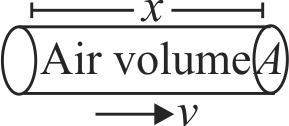355523 A wind - powered generator converts wind energy into electrical energy. Assume that the generator converts a fixed dfraction of the wind energy intercepted by its blades into electrical energy. For wind speed \(v\), the electrical power output will be most likely proportional to
355524 A body of mass 1 \(kg\) begins to move under the action of a time dependent force \(\vec{F}=\left(2 t \hat{i}+3 t^{2} \hat{j}\right) N\), where \(\hat{i}\) and \(\hat{j}\) are unit vectors along \(x\) and \(y\) axis. What power will be developed by the force at the time \(t\) ?
355523 A wind - powered generator converts wind energy into electrical energy. Assume that the generator converts a fixed dfraction of the wind energy intercepted by its blades into electrical energy. For wind speed \(v\), the electrical power output will be most likely proportional to
355524 A body of mass 1 \(kg\) begins to move under the action of a time dependent force \(\vec{F}=\left(2 t \hat{i}+3 t^{2} \hat{j}\right) N\), where \(\hat{i}\) and \(\hat{j}\) are unit vectors along \(x\) and \(y\) axis. What power will be developed by the force at the time \(t\) ?
355523 A wind - powered generator converts wind energy into electrical energy. Assume that the generator converts a fixed dfraction of the wind energy intercepted by its blades into electrical energy. For wind speed \(v\), the electrical power output will be most likely proportional to
355524 A body of mass 1 \(kg\) begins to move under the action of a time dependent force \(\vec{F}=\left(2 t \hat{i}+3 t^{2} \hat{j}\right) N\), where \(\hat{i}\) and \(\hat{j}\) are unit vectors along \(x\) and \(y\) axis. What power will be developed by the force at the time \(t\) ?
355523 A wind - powered generator converts wind energy into electrical energy. Assume that the generator converts a fixed dfraction of the wind energy intercepted by its blades into electrical energy. For wind speed \(v\), the electrical power output will be most likely proportional to
355524 A body of mass 1 \(kg\) begins to move under the action of a time dependent force \(\vec{F}=\left(2 t \hat{i}+3 t^{2} \hat{j}\right) N\), where \(\hat{i}\) and \(\hat{j}\) are unit vectors along \(x\) and \(y\) axis. What power will be developed by the force at the time \(t\) ?
